Introduction
Brazil is one of the largest producers and exporters of beef in the world (ABIEC, 2019). Although in recent years, beef exports have been significant and of great economic importance, cattle increasingly compete for physical/ economic space with agricultural crops (Lima et al., 2013). With the economic globalization of agribusiness (Silva et al., 2009) the production of cattle in Brazil needs to establish production systems that can efficiently produce quality meat at low prices (Euclides et al., 2001). In addition, these systems must be competitive, sustainable, and able to produce early animals. Given these challenges, knowledge on reproduction, genetics, and drugs has been applied to increase the efficiency of artificial insemination (AI) and the use of AI protocols of a fixed time (AIFT). This has resulted in increased efficiency in the use of reproductive animal husbandry, which is an important tool for genetic improvement and increased productivity (Neri et al., 2015). Valle (2011)) reported that reproduction was the basis for increasing zootechnical indexes. According to Sá Filho et al. (2009)), production modern livestock require the use of reproductive indexes (such as pregnancy rate, service index, birth interval, and birth rate) to plan this activity within the farm.
A heifer reaches puberty once gametes are released and when all stages of sexual behavior are established (Hafez and Hafez, 2004). Reproductive characteristics have been sought to reduce the age of first calving to optimize the reproductive performance of females (Silva et al., 2005). According to Freitas et al. (2011)), this physiological condition is influenced by the weight of the animals. In this sense, AIFT allows the synchronized induction of ovulation in heifers at predetermined times, reducing the interval between births, and allowing the conception and concentration of mating services and births to be planned (Bó et al., 2003; Neri et al., 2015).
Gottschall et al. (2012)) noted that the success of ovulation synchronization with AIFT in cut matrices depended on the efficacy of the protocols employed and the application of drugs. However, results have been associated with management, body condition score, and previous knowledge on the physiological status of the animals for the implementation of AIFT and subsequent biotechnological success (Maziero et al., 2012). Thus, the most frequently applied AIFT protocols in beef cattle are associated with intravaginal devices containing progesterone, estradiol, and prostaglandin (PGF2a), as well as protocols associated with the gonadotropin-releasing hormone (GnRH) and PGF2a called Ovsynch (Bó et al., 2002). In addition, progesterone can be administered orally (melengestrol acetate, MGA) or via subcutaneous implants (norgestomet) (Stevenson et al., 2003; Borges and Macedo, 2003; Rodrigues, 2016).
Oral MGA helps to prevent the occurrence of premature luteolysis, or short cycles (Sá Filho,2007), by increasing the fixation of the corpus luteum and enhancing conception rates (Wood-Follis et al., 2004). In addition to stimulating follicular development, it allows greater efficiency of GnRH in the protocol (Meneghetti et al., 2001).
Based on a study by Valle (2011)) anticipation of age at first calving and shorter calving intervals were found to be fundamental for increasing the rate of return on capital, as well as promoting efficiency in the use of pasture with early identification of unproductive animals. However, the costing and determination of profitability represent challenges that must be overcome for agricultural companies to be competitive (Cogan, 1999). The cost of using biotechnology and drugs to increase the rate pregnancy of bovine females is fundamental for evaluating the financial impacts of each activity involved in the rural enterprise. By utilizing economic results, the producer can consciously make decisions and view their production system as a company (Lopes and Carvalho, 2002).
The objective of the present study was to evaluate the induction of puberty in precocious (early-cycle) and conventional-cycle Bos taurus indicus Nellore breed heifers using an intravagjnal device and MGA to determine the economic viability of these techniques.
Material and methods
The experiment was carried out at Nossa Senhora Aparecida Farm (20.43°S, 55.28°W), municipality of Terenos, Mato Grosso do Sul, Brazil, on 891 nulliparous Nellore heifers from July 17, 2015 to September 16, 2015. The animals were maintained in pastures of Urochloa brizantha cultivar Marandu with a protein mineral supplement supplied ad libitum (Table 1). All animals were previously identified and evermined, and the groups were homogenized to determine the body condition score (BCS) of the groups, using the scale of 1 to 5 as proposed by Edmonson et al. (1989)).
Table 1 Guarantee levels per kg of protein mineral supplement of Nellore heifers treated with artificial insemination of a fixed time (AIFT)
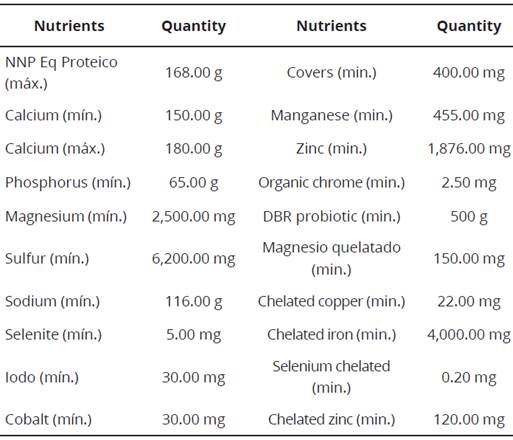
Basic composition of product: Starea® 200 S, urea, calcium carbonate, di- calcium phosphate, common salt, sulfur, magnesium oxide, calcium iodate, zinc oxide, sodium selenite, cobalt sulfate, copper sulfate, manganese sul fate, chelated minerals, organic chromium, DBR (ruminal bacteria), palat- abilizer. Estimated consumption 100 to 120 g per animal per day.
The experimental design was completely randomized in a 2 x 3 factorial scheme and included two age classes with 348 precocious (early) cycle (16-18 months) heifers with an average weight of 264.6 kg and 543 conventional- cycle (24-26 months) heifers with a mean weight of 346.8 kg. The three treatments were as follows: treatment-1, control without the induction of follicle formation (116 heifers in the early cicle and 181 in the conventional cycle); treatment-2, induction with an intravaginal implant reused by fourth time (intravaginal implant of progesterone inserted on day 0 (D0) and removed on day 12 (D12), when 1 ml of intramuscular estradiol cypionate [ECP®) was administered] having 116 heifers in the early cycle and 181 in the conventional cycle; and treatment-3, MGA induction protocol with 2.3 g/day supplied for 12 days, and at the end of the treatment, 1 ml of intramuscular ECP® was administered (116 heifers in the early cicle and 181 in the conventional cycle).
After 10 days of induction treatment, all flock, including the control group, were subjected to the AIFT protocol, with the first day of the protocol considered as D0. Animals received a used intravaginal progesterone implant (fourth use) and were administered 2 ml of estradiol benzoate (Estrogin® 5 mg, Biofarm, tecnologia em veterinária, Brasil) intramuscularly. The second treatment was administered on day 7 (D7) and included 2.5 ml of intramuscular prostaglandin analogue (Lutalyse®, dinoprost trometamine, 6.71 mg (equivalent to 5mg/mL of dinoprost), Zoetis Indústria de Produtos Veterinários Ltda, Brasil). On day 9 (D9), the intravaginal implants were removed and 0.3 ml of intramuscular estradiol cypionate (ECP®, 2 mg, Zoetis Indústria de Produtos Veterinários Ltda, Brasil) and 1.5 ml of eCG (Novormon®, equine chorionic gonadotropin, 200 Ui (eCG, PMSG), Zoetis Indústria de Produtos Veterinários Ltda, Brasil) were applied. On day 11 (D11) the heifers were submitted to artificial inseminating (AI) using commercial Angus bull semen mechanically deposited in the female reproductive system with a universal bovine applicator. The AIFT design rate (% of heifer pregnant/total heifer inseminated at a fixed time) was determined via the confirmation of gestation by ultrasonography after 30 days following AI.
The methodology utilized in the present study to calculate production costs expressed in American Dollars (US$) was via the division of effective operational cost, total operational cost (TOC), and total cost (TC) based on the method described by Hoffmann et al. (1987)). The costs were determined based on disbursements made during the 60-day production cycle. Costs were allocated in amounts spent per animal and classified as supplementation, labor, rent, health, maintenance, capital invested, capital interest, and working capital interest considering the expenditures of the technique of synchronization of ovulation and AI at a fixed time in each group, expenditure on hormones, staff displacement, value of semen doses, labor costs for insemination, and diagnosis of gestation. The classification of costs allowed for the identification of results and profitability indicators, which served as the basis for the analysis of the second production methodologies defined by Lazzarini Neto (1995)). Total revenue (TR) was defined as the sale of pregnant females at the fixed value of 15 @, for example, if the heifer was pregnant and weighing 368 kg of BW, it was considering having 15 @ and empty females at the market value, gross margin (GM) = (TR - TOC), economic profitability (EP) = (Tr - tC), profitability was attributed to the division of EP by TC, and the profitability and result of the division of EP was divided by the total investment.
Economic data were tabulated in a Microsoft Excel® program for economically viable results. During economic evaluation, the biological data obtained (pregnancy rate) were used for each experimental group, comparing the values of the results.
Cross-reference tests of independent samples were performed, crossing the tables of the collected variables. After these preliminary tests the more adjusted tests were performed, so for the biological data of gynecological diagnosis and diagnosis of pregnancy were submitted to chi-square tests (P < 0.05) and Pearson’s correlations, for initial weight the data were submitted to analysis of variance (P < 0.05) and, in the case of a significant difference in ‘F’ test results, the statistical program SAS version 9.1 (2004) was applied.
Results
Significant difference (P < 0.05) was observed only for weight among the different female age classes. These differences were related to the age of the animals. Regarding the different treatments, there was no significant differences (P > 0.05) in weight (Table 2). The gynecological diagnosis and pregnancy of heifers revealed a significant difference (P < 0.05) among treatments (Tables 3 and 4).
Table 2 Weight and N of nulliparous females submitted for follicular and AIFT inductions

P1-effect between classes. P2-treatment effect; Averages within the same line with different lowercase letters were significant for class effect by the F Test (P < 0.05).
Table 3 Gynecological diagnosis and pregnancy of nulliparous females submitted to follicular and AIFT inductions

P1-effect between classes; P2-treatment effect; The same line averages with different letters represent significant treatment effects by chi-square test (P < 0.05).
Table 4 Pear correlation between the average weight in kg (weight), body condition score (BCS), diagnosed presence of corpus luteum (CL), and diagnosis of pregnancy (Pregnancy) of nulliparous females submitted to follicular and AIFT inductions
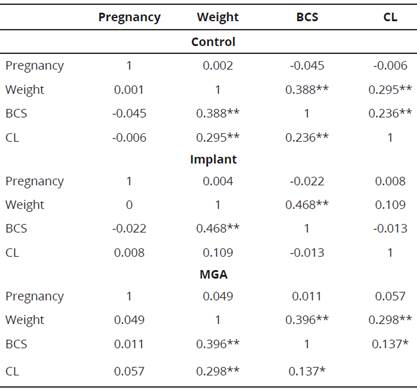
** The correlation is significant at the 0.01 level (2-tailed). * The correlation is significant at the 0.05 level (2-tailed).
Heifers induced via implantation had a higher rate of ovarian activity (presence of corpus luteum) during the early cycle (63.8%) and conventional cycle (72.4%) than the other treatment groups, with the highest index of females in the cycle depending on the physiological age of the animals. This effect influenced the frequency of early stage anestrus (56%). Among the treatments, 72% of control heifers had no ovarian activity, which was determined by the absence of the corpus luteum.
Higher conception rates were observed for heifers induced via implantation, at 65.5% and 62.4% for females in the early-cycle and conventional-cycle groups, respectively. This was also observed with MGA, where obtained conception rates for precocious females were 52.6% and conventional females were 55.8% (Table 3). There were differences among the capital interest costs in conventional-cycle heifers than in early-cycle heifers, with the former presenting a value 31.01% higher than the latter (Table 5).
Table 5 Center costs (USD) for nulliparous Nellore females submitted to follicular and AIFT inductions
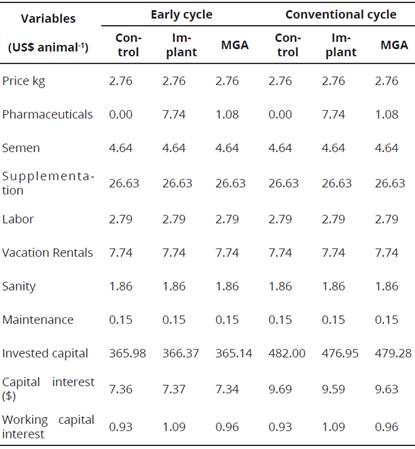
The economic feasibility analysis per animal identified an effective operational cost with higher value when using the implant induction protocol. The animals in the control group cost US$ 46.57 and those treated with MGA cost US$ 47.65 during the experimental period, i.e., with the use of only the AIFT protocol, there was a reduction of 16.61% in the effective operational cost per animal. When the results of the treatment with MGA were compared, the reduction was 13.96% among treatments (Table 6).
Table 6 Viability of economic indicators (USD) of the nulliparous Nellore females submitted to follicular and AIFT inductions
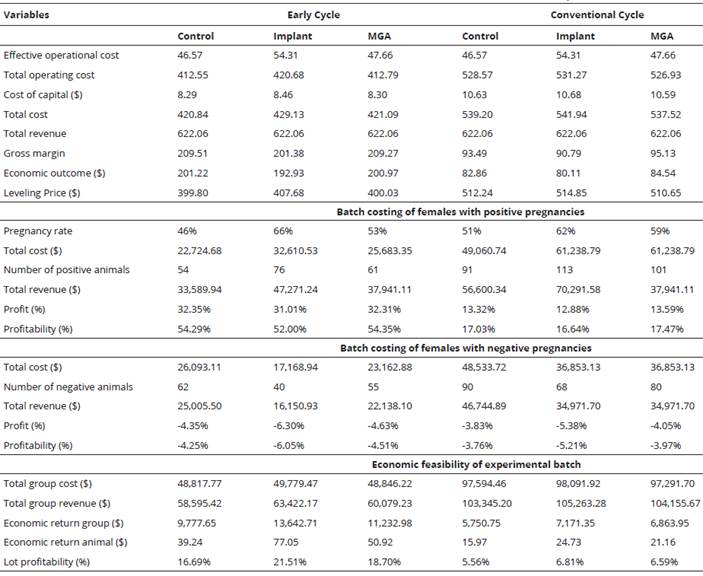
The results for the production systems were also significant for TC, with the early- cycle heifers being 21.46% lower than the conventional-cycle heifers, which presented a value of US$ 528.85. This difference is associated with a higher investment cost for conventional-cycle animals (Table 5).
Discussion
From the results of the present study, it can be inferred that the induction protocol with the fourth-use implant and MGA before AIFT were superior to the control treatment, being 23.28% and 11.03%, respectively. This can be attributed to elevated exogenous progesterone (P4) rates, which possibly reduced the occurrence of premature luteolysis or short cycles (Sá Filho, 2007), inhibited luteinizing hormone secretion during induction, and suppressed follicular growth (Dogi, 2005) in females containing a corpus luteum. However, the early conception indexes of females were higher than the proportion of animals with ovarian activity. According to Baruselli et al. (2002)), implantation of the P4 implant on D0 together with the benzoate of estradiol induced a new follicular wave, favoring animals in anestrous.
In the present study, there were no differences between the conception rate associated with BCS, since 91.1% of heifers in the early-cycle group had BCS level 3 and the conventional-cycle group presented only 1.7% of BCS level 2 (Figure 1). Gottschall et al. (2012)) found that animals with a BCS above level 2.5 had a higher rate of conception. This was also reported by Sá Filho et al. (2009)) who showed that for AIFT to obtain a minimum of 40% positive pregnancies, the mothers submitted to the protocol must have an BCS score above level 2.5.
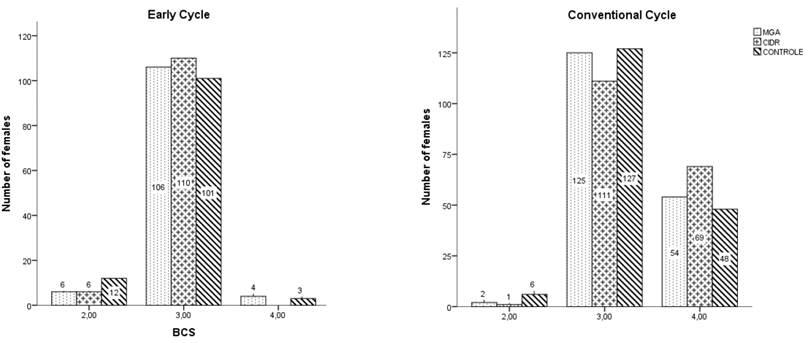
Figure 1 Relationship between body condiction score (BCS) of nulliparous Nellore female early-cycle classes (left) and conventional-cycle classes (right).
From the results observed in the present study, the pregnancy rate following induction with the fourth-use implant was positively influenced by the weight and BCS of the heifers. According to Wheaton and Lamb (2007)), intravaginal progesterone implants in animals with adequate BCS stimulates estrus, increasing conception rates.
However, under both the control and MGA induction treatments, the presence of the corpus luteum can be inferred as a response factor for the pregnancy rate (Table 4). The negative relationship between pregnancy rate and the presence of the corpus luteum is possibly related to the morphology or physiological status of the follicles (Peter et al., 2009). Rhodes et al. (2003)) noted that the subluteal concentration of progesterone influenced the response in acyclic and cyclic animals. This is because AIFT in animals with small follicles reduces reproductive efficiency, which probably results in the formation of a smaller corpus luteum due to lower concentrations of progesterone (Burke et al., 2001). With MGA induction, the dominant follicle was maintained. Cerri et al. (2009)) reported that the use of exogenous progesterone might stimulate ovulation and corpus luteum formation in animals with dominant follicles above 10 mm in diameter.
The income values of animals with positive pregnancies were the same because the sale of animals occurred with pregnant females having a value fixed at 15 @ for animals (in Brazil it is used trade live animals using the arroba (@) index, so considering 50% of carcass yield one animal having 15 @ will weight 450 kg of live body weight). Revenue values for non-pregnant females from the conventional cycle were obtained when the animals were sold for slaughter, presenting an average value of US$ 516.99, and females from the early cycle were sold for termination with an average income of US$ 403.14 per animal.
When evaluating the profitability of pregnant females, the highest rate was observed for early- cycle animals (53.54%). Although females with a conventional cycle presented lower results, the values obtained were satisfactory when compared to fixed yield financial investments in the market. The profitability of nonpregnant females was unsatisfactory over the experimental period owing to the relationship between the production costs and revenue obtained during this period.
However, the results showed a higher economic return per animal with the use of implant induction, at US$ 77.04 and US$ 24.73 for females in the early and conventional-cycle groups, respectively, considering the average results for the experimental lots. With the reduced conception rate in the control group of the early and conventional-cycle groups, the economic return was reduced by 49.07 and 35.42%, respectively.
Thus, the results of average batch profitability with implant induction were superior to that with the MGA (18.70%) and control (16.69%) treatments for the early-cycle animals. This was observed for animals in the conventional cycle and animals with implant induction, with above average profit per batch.
Regarding the production cycles, the profitability of the early-cycle animals was 12.61% higher than that of conventional-cycle animals. Therefore, the use of females aged 16-18 months in AIFT under conditions of forage and supplementation that are equivalent to the requirement of their nutritional needs provides a higher remuneration of capital for agricultural enterprise not only when the short cycle of livestock is used, when the animals for sale stay for a short time in the property. Thus, the definition of production and reproduction objectives involves establishing strategies for the rational use of breeding biotechnologies to determine the economic return of livestock activity at short time. Hormone therapy, when appropriately applied, contributes to increased reproductive efficiency and a favorable cost-benefit ratio to the producer (Sá Filho, 2007).
Conclusión
It was concluded that the induction of precocious heifers provided a higher pregnancy rate, was a preponderant factor in animal production systems, and increased the economic return compared to conventional-cycle animals. An induction protocol that utilizes reused implants is recommended for groups of heifers in early and conventional cycles by virtue of obtaining a higher AIFT pregnancy rate and profitability compared to MGA and control groups.














